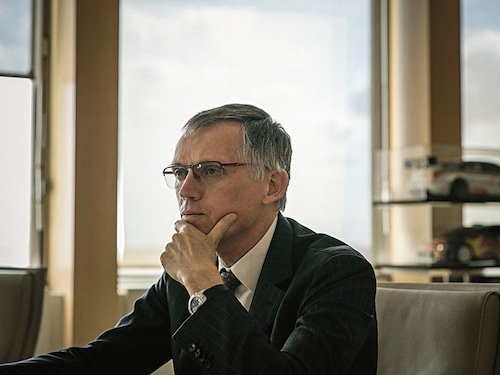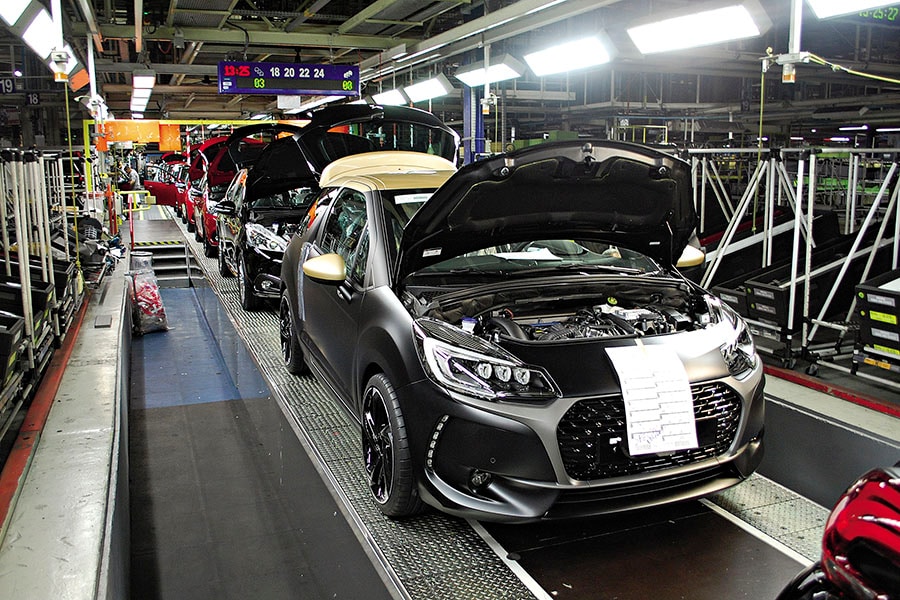Peugeot on the go
After resurrecting the French carmaker Groupe PSA, Carlos Tavares is taking on the global giants by gambling on bleeding-edge manufacturing techniques and selling services that support other companies


Carlos Tavares, the CEO of Groupe PSA: “Growth is the result of a job well done”
Image: Laura Stevens for Forbes
Quick: What comes to mind when you think of the French carmaker Peugeot? Quality? Probably not. Performance? Um, unlikely. How about innovation? Doubt it.
So you’ve got to appreciate the candour of Carlos Tavares, the chief executive of France’s Groupe PSA, which makes Peugeot, Citroën and DS brand vehicles and ranks a distant 10th globally in terms of vehicle sales. “We are dinosaurs,” he says plainly of his 207-year-old company, which produced coffee mills and bicycles before automobiles. “And if we don’t want to disappear like dinosaurs, we have to operate in a different way.”
How can a second-tier French car company compete in the age of Uber and Tesla? Tavares’s strategy is twofold. First, cutting-edge efficiency. Spend wisely, but take chances on emerging manufacturing methods like 3D printing and embrace unconventional business opportunities, like selling cheap, generic vehicles to car-sharing services. Second, an expanded customer base. PSA would like to turn occasional car buyers into lifetime transportation subscribers through its Free2Move service, which aims to be a single, worldwide app supporting everything from car sharing and leasing to corporate-fleet management. Importantly, Free2Move will not be limited to PSA’s brands, and it is the Trojan horse for Tavares’s plans to re-enter the American market, where PSA hasn’t sold cars for 26 years.
Unsexy? Yes. But it’s a clever way of playing a bad hand by one of the auto industry’s most thoughtful leaders. And it just might work.
After all, Tavares has a way of making things happen. Once a top lieutenant to Renault-Nissan Alliance chief executive Carlos Ghosn, Tavares was famously out of a job after telling a reporter in August 2013 that he wanted to be a CEO. He got his wish: A few months later, he was chosen to run a nearly bankrupt PSA.
He gave himself three years to turn PSA around but did it in two. By consolidating factory space and running machinery more efficiently, plus benefiting from his predecessor’s elimination of 11,200 jobs, Tavares slashed PSA’s fixed costs by $1.4 billion and lowered its breakeven point from 2.6 million vehicles to 1.6 million. (It sold 3.1 million in 2016.) Those savings, coupled with higher prices on newer models, helped PSA’s operating margins bounce back from—2.8 percent in 2014 to 6 percent in 2016, among the best in the industry. With PSA newly flush, Tavares surprised the industry last March, striking a $2.6 billion deal (at current exchange rates) to buy the long-beleaguered Opel/Vauxhall division of General Motors.
It was a gutsy move. Opel/Vauxhall has been losing money for nearly two decades, but Tavares believes he can fix it by introducing the same manufacturing efficiencies he did at PSA, and if it works, the acquisition should strengthen PSA in Europe, particularly in Germany. (Germans buy French cars with the same enthusiasm the French buy German cheeses.) PSA’s stock, which trades primarily in Paris but also in limited volumes on the American over-the-counter market, is up more than 55 percent since Tavares became CEO, recently reaching 18 euros a share, which gives it a market capitalisation of $19.7 billion.
Though he’s led a nice turnaround, Tavares is in a tough spot. With $63 billion in revenue, PSA isn’t big enough to match the massive R&D budgets of top global players like Volkswagen ($253 billion in sales), Toyota Motors ($248 billion) and General Motors ($166 billion). It’s overly dependent on Europe. In China, the world’s biggest market, PSA’s sales are collapsing, down 49 percent so far in 2017. And it doesn’t even sell cars in the world’s second-largest market—the United States. PSA’s Poissy plant: To maximise profits, the factory outside Paris will build only premium compact cars like the DS3
PSA’s Poissy plant: To maximise profits, the factory outside Paris will build only premium compact cars like the DS3
“Peugeot is still going to be plagued by issues that have plagued middle-tier carmakers forever, like being able to afford new engines and electric-vehicle platforms,” says Mike Ramsey, an automotive research director at Gartner. “But they have the ability to be a first mover in the part of the business that is changing and to be a front-runner. They have an opportunity to experiment without encumbrances.”
Take car sharing. Morgan Stanley says shared cars could account for 26 percent of global miles travelled by 2030, up from 4 percent in 2015. PSA wants to be a provider of those “pay-as-you-go” services and already has 1 million customers through various partnerships with French-based car-sharing players like TravelCar and Koolicar. Of course, every other carmaker, not to mention countless Silicon Valley startups, is trying to figure out the same game. Margins are higher (roughly 50 percent on digital apps, compared with 4 percent on a $30,000 vehicle), but success depends on building a huge user network.
That’s where PSA has an edge. Instead of operating a bunch of localised car-sharing services in multiple cities or countries, it wants to be an aggregator providing a single app that lets you book a car from any provider, anywhere in the world. Launched in February, the Free2Move app has 300,000 users and offers services from 25 mobility providers in 18 cities in seven countries. It’ll take a long time to scale up, but Tavares is aiming for $300 million in revenue from shared-mobility services by 2021. The bigger idea is to build lifetime relationships with customers by offering everything from used-car sales and fleet maintenance to auto parts—covering all car brands, not just those made by PSA.
Tavares sees such car-sharing services as a way to tiptoe back into the US market. Again, it’s an unorthodox approach. Instead of spending billions to build factories and set up dealer networks, he’s starting out by selling access to other brands’ vehicles. Over time he’ll add PSA’s brands to those shared fleets until, a decade from now, PSA will be ready to sell its own cars in the US again. Without a clunky dealer network, PSA is free to invent a new digital-sales channel that suits the needs of modern consumers, says Larry Dominique, the American executive leading the effort. “It’s not like I have 500 or 1,000 dealers I’m trying to convince to do business in a new way.”
Likewise, Tavares is willing to be the guinea pig for industrial-scale 3D printing to dramatically improve PSA’s manufacturing efficiency. Until now automakers have used 3D printing primarily for plastic prototype parts. But the technology is moving fast, with ever bigger machines able to produce larger components from a variety of advanced materials, including metals. PSA is the first to partner with the California startup Divergent3D, whose founder, Kevin Czinger, figured out how to make a lightweight car chassis by using complex 3D-printed metal joints as the “connective tissue” that attaches to the carbon-fiber structure, or “bones,” of the car.
With promises to cut up to an astounding 80 percent of traditional factory costs, Divergent3D’s technology has the potential to alter the economics of mass manufacturing and make it feasible to produce cars profitably in small batches of 10,000 or 20,000—something that doesn’t make sense today in a $1 billion factory using traditional methods. That kind of breakthrough excites Tavares, whose bet is that PSA can set up microfactories in distant countries that require local manufacturing or in choked cities that need their own fleets of shared vehicles to move people around. “We are talking about a radical change for our industry,” Tavares says.
It’s only a matter of time before someone figures out how to make 3D metal printing work on an industrial scale for automobiles. It might as well be him.
“Tavares is hungry,” Czinger says.
As are most dinosaurs—at least, the ones that survive.
First Published: Sep 14, 2017, 06:35
Subscribe Now